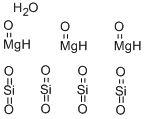TALC
Synonym(s):BMPR3;BMPR-II;BMR2;BRK-3;PPH1
- CAS NO.:13376-74-4
- Empirical Formula: H2Mg3O12Si4
- Molecular Weight: 379.27
- MDL number: MFCD00792903
- EINECS: 238-877-9
- SAFETY DATA SHEET (SDS)
- Update Date: 2024-02-18 17:28:16

What is TALC?
Chemical properties
White, apple-green, gray powder; pearly or greasy luster, greasy feel. Mohs hardness 1–1.5 (may be harder when impure), high resistance to acids, alkalies, and heat.
The Uses of TALC
Chiefly as a ceramic insulator in electronic devices.
The Uses of TALC
Pigment in paint, varnishes; filler for paper, rubber, soap; lubricating molds and machinery; heat insulator.
Definition
A natural hydrous magnesium silicate. Compact, massive varieties may be called steatite in distinction from the foliated varieties, which are called talc. Soapstone is an impure variety of steatite.
Definition
An extremely soft greenish or white mineral, a hydrous silicate of magnesium. Purified it is sold as talcum powder, and it is used as a lubricant, a filler (in paint and rubber) and an ingredient of some ceramics.
Definition
A white or pale-green mineralform of magnesium silicate,Mg3Si4O10(OH)2, crystallizing in thetriclinic system. It forms as a secondarymineral by alteration of magnesium-rich olivines, pyroxenes, andamphiboles of ultrabasic rocks. It issoaplike to touch and very soft, havinga hardness of 1 on the Mohs’scale. Massive fine-grained talc isknown as soapstone or steatite. Talcin powdered form is used as a lubricant,as a filler in paper, paints, andrubber, and in cosmetics, ceramics,and French chalk. It occurs chie?y inthe USA, Russia, France, and Japan.
Hazard
Toxic by inhalation. Effects pulmonary function and causes pulmonary fibrosis. Questionable carcinogen.
Health Hazard
The fibrous talc in soapstone dust causes fibrotic pneumoconiosis; an increased incidence of cancer of the lungs and pleura has been reported.
Industrial uses
Steatites are noted for their excellent electricalproperties and low cost. They are easily formedand fired at relatively low temperatures. However,compositions containing little or no clayor plastic material present fabricating problemsbecause of a narrow firing range. Steatite partsare vacuum-tight, can be readily bonded toother materials, and can be glazed or ground tohigh-quality surfaces.
Properties of TALC
| Melting point: | 800 °C |
| Density | 2,7 g/cm3 |
| refractive index | 1.54-1.59 |
| storage temp. | -70°C |
| form | Talclike material of varying
composition, but generally grayish-white, fine,
odorless power. It is noncombustible and
insoluble in water. |
| Dielectric constant | 5.5 - 7.5(0.0℃) |
Safety information for TALC
| Signal word | Danger |
| Pictogram(s) |
 Exclamation Mark Irritant GHS07  Health Hazard GHS08 |
| GHS Hazard Statements |
H315:Skin corrosion/irritation H319:Serious eye damage/eye irritation |
| Precautionary Statement Codes |
P202:Do not handle until all safety precautions have been read and understood. P264:Wash hands thoroughly after handling. P264:Wash skin thouroughly after handling. P280:Wear protective gloves/protective clothing/eye protection/face protection. P302+P352:IF ON SKIN: wash with plenty of soap and water. P305+P351+P338:IF IN EYES: Rinse cautiously with water for several minutes. Remove contact lenses, if present and easy to do. Continuerinsing. P308+P313:IF exposed or concerned: Get medical advice/attention. |
Computed Descriptors for TALC
New Products
(S)-3-Aminobutanenitrile hydrochloride 4-Methylphenylacetic acid N-Boc-D-alaninol N-BOC-D/L-ALANINOL Tert-butyl bis(2-chloroethyl)carbamate 3-Morpholino-1-(4-nitrophenyl)-5,6-dihydropyridin- 2(1H)-one Furan-2,5-Dicarboxylic Acid Tropic acid 1-Bromo-3,5-Di-Tert-Butylbenzene S-2-CHLORO PROPIONIC ACID ETHYL ISOCYANOACETATE 2-Bromo-1,3-Bis(Dimethylamino)Trimethinium Hexafluorophosphate 4-IODO BENZOIC ACID 3-NITRO-2-METHYL ANILINE 1-(2,4-DICHLOROPHENYL) ETHANAMINE (2-Hydroxyphenyl)acetonitrile 4-Bromopyrazole 2-(Cyanocyclohexyl)acetic acid 4-methoxy-3,5-dinitropyridine 1-(4-(aminomethyl)benzyl)urea hydrochloride 2-aminopropyl benzoate hydrochloride diethyl 2-(2-((tertbutoxycarbonyl)amino) ethyl)malonate tert-butyl 4- (ureidomethyl)benzylcarbamate Ethyl-2-chloro((4-methoxyphenyl)hydrazono)acetateRelated products of tetrahydrofuran








You may like
-
 BMPR2 (174-end), active, His tagged human CASView Details
BMPR2 (174-end), active, His tagged human CASView Details -
 2033-24-1 98%View Details
2033-24-1 98%View Details
2033-24-1 -
 1975-50-4 98%View Details
1975-50-4 98%View Details
1975-50-4 -
 2-HYDROXY BENZYL ALCOHOL 98%View Details
2-HYDROXY BENZYL ALCOHOL 98%View Details
90-01-7 -
 2-Chloro-1,3-Bis(Dimethylamino)Trimethinium Hexafluorophosphate 221615-75-4 98%View Details
2-Chloro-1,3-Bis(Dimethylamino)Trimethinium Hexafluorophosphate 221615-75-4 98%View Details
221615-75-4 -
 61397-56-6 CIS BROMO BENZOATE 98%View Details
61397-56-6 CIS BROMO BENZOATE 98%View Details
61397-56-6 -
 14714-50-2 (2-Hydroxyphenyl)acetonitrile 98+View Details
14714-50-2 (2-Hydroxyphenyl)acetonitrile 98+View Details
14714-50-2 -
 118753-70-1 98+View Details
118753-70-1 98+View Details
118753-70-1